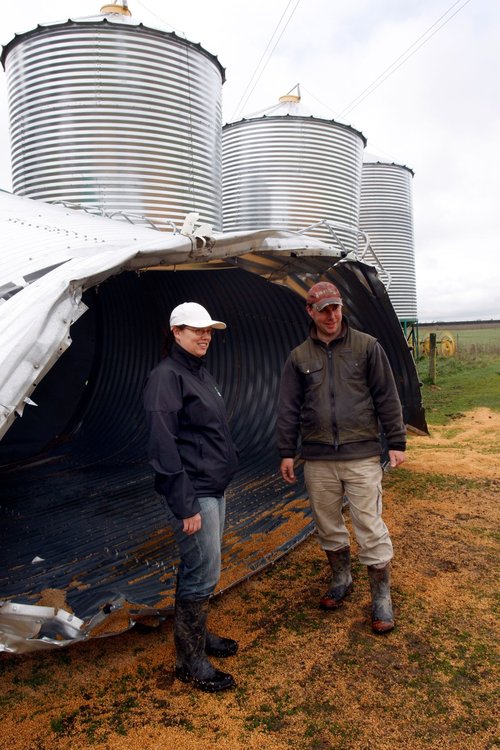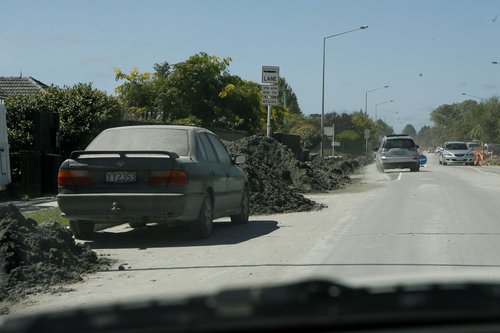The Farmy Army
Rural Cantabrians lend support to the City
Luis Paterson
Like the Student Volunteer Army (SVA) the Farmy Army (FA) began as a spontaneous volunteer response to the 150 farms that received major damage in the 4 September 2010 earthquake. Its epicentre, 40km west of Christchurch and 10km deep, opened wounds in the earth across the rural community of Darfield. The newly discovered Greensdale fault became a directly visible obstacle to dairying and agriculture – grain silos collapsed like empty cans, power outages halted milking, and deformed roads made it difficult for tankers to ply their usual routes. The timing of the earthquake, 4.46am, threatened to throw the milking routine into disarray. Yet Farmers wasted no time in taking stock. Those who had generators rallied to distribute them, intact milk sheds marshalled as many cows as possible, and irrigation leaks were swiftly plugged to ensure cows and crops did not go without water. Federated Farmers provincial president Neil Stott and North Canterbury grain and seeds chairman Murray Rowlands coordinated much of this effort as the preexisting structural and social apparatus of the organisation (and related organisations such as Rural Women NZ) helped to facilitate the volunteer response. Rowlands, along with newly appointed earthquake spokesman John Hartnell and catering coordinator Helen Heddell, formed the core leadership team of the Farmy Army in February 2011.

Federated Farmers representatives Murray Rowlands and Carly Sluys inspect a damaged grain silo, Burnham, 8 September 2010. Credit: David Hallett, Fairfax Media. Source: https://quakestudies.canterbury.ac.nz/store/object/92075
Canterbury’s farms were mostly unscathed in the 22 February 2011 earthquake. Yet farmers did not want to sit idle in the wake of the devastation in the central city and the tide of liquefaction across the east. The Federated Farmers team coordinated 4000 rural volunteers from their headquarters at Ngā Puna Wai Canterbury Agricultural Park in Hillmorton. The Farmy Army did not put any restrictions on who could volunteer – those who offered to help were sorted into a place where they could help to the best of their ability. Entire families took up the spade or the spatula to clear silt and keep everyone fed, from the youngest volunteer aged 10 to the oldest aged 86. The FA’s access to heavy machinery complemented the Student Volunteer Army’s primarily shovel and wheelbarrow-based effort. FA diggers opened the roads to allow SVA and other vehicles access, ground teams cleared individual houses, and then the piles of ejecta were removed by truck-trailers. By March 11 the FA had removed 70,000 cubic metres of silt from Christchurch. This unplanned co-ordination evolved into an organised collaborative response with the SVA to the 13 June aftershock. Alongside clearing liquefaction the FA had a major role in supplying food to the eastern suburbs. Farmers who could not volunteer their time directly instead gave meat and produce. These donations were prepared into meals and distributed by the FA, particularly in the wake of the June aftershock. The Farmy Army continues as a volunteer organisation and most recently assisted in the 2023 Cyclone Gabriel response.

Liquefaction sorted into piles to be removed by Farmy Army trailers, Dallington, 27 February 2011. Credit: Richard Cosgrove, Fairfax Media. Source: https://quakestudies.canterbury.ac.nz/store/object/89958
Resources
- The National Library has an extensive archive of the Federated Farmers website with snapshots every year from 2010 to 2022. It is a particularly useful source in tracking how the Farmy Army began as a spontaneous response to the 4 September earthquake, developed into a distinct volunteer organization after the 22 February earthquake, how the FA operated and who the key leaders were, and how farmers were impacted by and responded to the earthquakes in general.
- Quake 2010 from the 10 October 2010 snapshot collates fact sheets and public advisories issued by Environment Canterbury about shifting boundaries, damaged irrigation and water bores, and how to remediate fault scarp. The minutes of the “What a week” meeting 9 September (attended by 500 farmers) gives insight into how farmers were reflecting after the initial disaster response including how to approach insurance, the Earthquake Commission, and the local and central government response. The daily updates from 4 to 25 September provide a narrative of the immediate concerns farmers faced such as providing power to milking sheds and water for stock.
- Canterbury earthquake 2011 from the 24 August 2011 snapshot archives news updates and Farmy Army activity from 22 February to 30 March and from 13 to 28 June. John Hartnell features as the Federated Farmers earthquake spokesman. “Big clean up being co-ordinated, expected to start tomorrow,” 25 February is the first call to action, inspired by the Student Volunteer Army, for tractors, loaders, excavators, and volunteers to operate them. “Canterbury earthquake update call for volunteers and help,” 26 Feburary revises this call to a two-tonne weight limit in response to the Council and notes that 500 farmers have already begun working in Christchurch. ‘Farmy Army’ removes 1,000 tonnes of earthquake debris from residential properties 26 February marks the first appearance of the Farmy Army moniker, ostensibly coined by Mayor Bob Parker. Of note are specific messages the FA wanted the media to promote regarding how to volunteer and the nature of the work.
- Christchurch Press 10 September 2010: Section B, Page 10 – Three articles detailing the affect of the 4 September earthquake on rural communities and the volunteer effort that would form the base of the Farmy Army. "Earthquake bowls silos like skittles," farmer Dudley Cridge from Kirwee and Federated Farmers North Canterbury Chairman Murray Rowlands inspect fallen grain silos and reflect on the quake’s impact. "Farmers counting cost," and "Praise for farmers' quick generosity," Federated Farmers and Fonterra organise assistance and distribute donated generators to the 150 farms damaged.
- Helen Heddell's Story – Farmy Army catering co-ordinator Helen Heddell’s 3 May 2012 interview as part of the National Council of Women Women’s Voices project. Heddell, aged 60 at the time of the interview, was a lifelong farmer and member of community organisations Federated Farmers and Rural Women New Zealand. She and her husband Peter were retired and living on a lifestyle block in Swannanoa during the 2010-2011 earthquake sequence and their daughter lived on the family farm in Darfield (page 2). As their house was largely undamaged the Heddell’s joined the spontaneous effort to share generators. Heddell attempted to volunteer directly at a welfare centre in Kaiapoi but was turned away to uphold privacy. Heddell was not impressed by this “precious” attitude: “You just think ‘Stuff it all.’ Leave them to it, if they don’t know how to channel (offers of help or) give you something to do.” (page 3).
- Heddell’s experience in September informed her leadership role in the Farmy Army in February. Despite having some success delivering baking to the Rangiora Welfare Centre (page 4) Heddell and other farmers were continually rebuffed by Council authorities who did not know where to direct them. In contrast, the Farmy Army “accepted all help coming…you think ‘that person’s capable of doing something…it’s just a case of finding the thing that would suit them best and sending them off with a shovel or a pen and paper or an egg-beater.’ (page 5). Heddell describes the how the FA catering team operated from the Addington Showgrounds and processed “tonnes” of donated meat (pages 5-6); the distribution process and how the FA came to cater for the entirety of the eastern suburbs (page 6-8); the regimented effort to cater after the 13 June 2011 aftershock and August meal drop in New Brighton (page 8); the pressure of being “expected” to provide food for Christmas (page 9) and giving “moral support” to 400 SVA volunteers after the 23 December 2011 aftershock (pages 9-10).
- Liquefaction ejecta clean-up in Christchurch during the 2010-2011 earthquake sequence – an academic article by M. Villemure et al from the UC Department of Geological Sciences that details the creation and clean-up of liquefaction. Of particular interest is the liquefaction area map (page 4), the methodology of the Council clean-up (page 5), and the coordination/communication between Council officials and volunteers (pages 6-8).
- Christchurch Press 11 March 2011: Section A, Page 14 | "Farmy Army put in the hard yards." – Federated Farmers earthquake spokesman John Hartnell reflects on the Farmy Army’s efforts and prepares for a ‘final cleanup’ of the city streets over the weekend of March 18-20. The Army, coordinated from its headquarters at Canterbury Agricultural Park, consists of 4000 volunteers who engaged in 28,000 man and machine hours to date. The FA also transported 5.5 million litres of water from Silver Fern Farms Islington reservoir to Christchurch.
- Christchurch Press 18 March 2011: Section A, Page 11 | “Final assault in battle against silt.” – The Farmy Army begins the last clean-up operation of March 2011 in earnest alongside the SVA. John Hartnell reflects on the consequences of the Tōhoku earthquake and tsunami on the farming sector.
- Christchurch Press 17 June 2011: Section A, Page 12 | "Farms spared major damage again." – Farmers prepare to mobilise the Farmy Army again to assist the eastern suburbs after the 6 June 2011 aftershock. The Farmy Army and Student Volunteer Army closely coordinate their response in Operation De-silt. The 1200 initial Farmy Army volunteers hand over the effort to the SVA after the students complete their exams (for details see Christchurch Press 24 June 2011: Section A, Page 13 "Mountain of silt tackled.").
- Farmy Army/SVA achieves great things….again, 28 June 2011 – John Hartnell reports on the combined volunteer Operation De-silt. 2340 volunteers cleared an estimated 100,000 cubic metres of silt across seven days from 21 to 28 June. Hartnell thanks the catering team and Rural Women NZ for keeping the volunteers fed and emphasises the “unheralded” effect of the aftershock on Banks Peninsular farmers.
- Christchurch Press 12 August 2011: Section A, Page 11 | “Farmy Army delivers comfort.” – Helen Heddell details the FA effort to distribute 600 meals to New Brighton, Sumner, and Lyttleton. The meals consisted of frozen meat donated by the Alliance Group, vegetables from Ashburton farmers, and suggested recipes from Beef + Lamb NZ. These meals proved immensely popular – 1200 residents lined up to receive one (Christchurch Press 13 August 2011: Section A, Page 5 | “Sunday roasts and vegetables just too popular.”) Heddell estimates that 5000 meals were cooked to keep volunteers fed during the February and June earthquake responses.
- Christchurch Press 17 December 2011: Section A, Page 9 | “Farmy Army delivers food parcels.” – Heddell details the Farmy Army’s “last hurrah” in packaging and delivering Christmas hampers to the eastern suburbs. 100 volunteers worked alongside the SVA and New Brighton police to distribute the hampers, which Heddell hoped would “encourage the same spirit of community we share in rural New Zealand.”
- Christchurch Press 9 March 2012: Section A, Page 17 | “Officialdom hampered good work.” – John Hartnell reflects on the Farmy Army and broad volunteer effort a year after the 22 February earthquake. “The Farmy Army and SVA did what comes naturally to most Kiwis: head to where help is needed,” Hartnell recalls, “Christchurch residents just wanted to do something positive for the city.” Hartnell is extremely proud that the FA served as a vehicle for this positive action, though he agrees with SVA founder Sam Johnson that Council officials held a “sniffiness” towards unofficial volunteers and an overabundance of administrative barriers held back their work.
